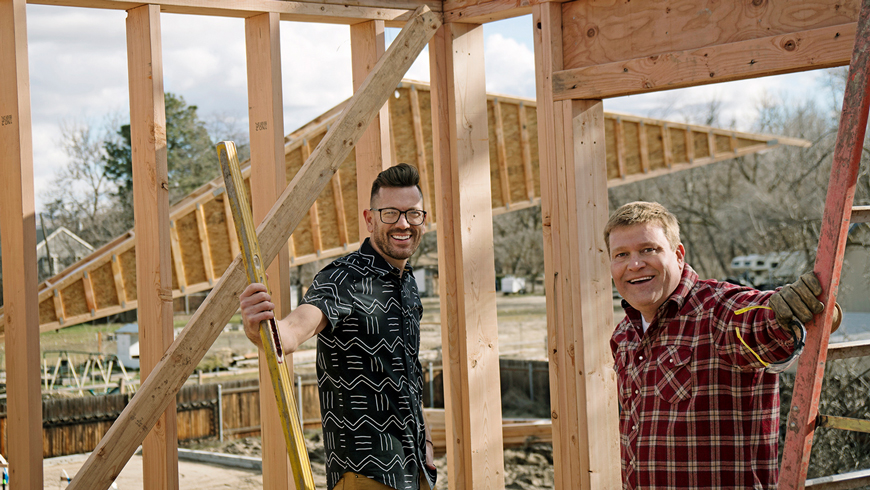Clint Robertson and Luke Caldwell, friends and the working partnership of HGTV’s “Boise Boys,” weren’t seeking business
collaboration when a mutual friend introduced them at a downtown Boise grocery store. “We went looking at houses that same day,” Robertson said.
Though complete opposites, something seemed right about a partnership, and many otherwise forgotten Treasure Valley properties have subsequently benefitted from their vision. Now, Robertson and Caldwell have flipped their renovation expertise—Robertson is practical contractor to Caldwell’s design guru—into a hit show on HGTV about flipping houses in Boise. In a free-form conversation we had recently in Boise, the two friends discussed everything from identifying which projects to undertake to what makes a house a home.
“The right house tells us, ‘I’m the one,’” Robertson said. “We don’t want to be somewhere that doesn’t need us. We want folks to truly say, ‘This home has been loved back.’ Homes, like people, need love.”
Caldwell put a finer point on it: “We try to find the ugliest house around. If it’s already as nice as the rest of the neighborhood, we can’t always add value. Creatively, everything’s on the table. We’ll ask what makes sense in that neighborhood financially and strategically, but when we start with a house that’s in desperate need of love, it usually ends up good.”
“Does it have a strong foundation? Where are loadbearing walls? That makes a difference on what we can do,” Robertson chimed in. “The story of redemption is what makes movies great, it’s what holds the world together. Most of the magic happens when first walking through a house in shambles, each [of us] trying to figure out what the house could be.
“It almost feels like the house is saying, ‘this is not right, I’m not right.’ Something’s wrong with flow, size, layout. It’s seen when you walk in. Things were functional, yet not inviting. You have the opportunity to take it to its highest and best form, without disregarding where it came from.”
“Keep the history,” Robertson emphasized, “but complement with better flow, design, and light. That’s what we look at when I say the house speaks to us. If walls cut up the ability for a family to gather, we want to correct that. The form and function can marry.”
“We’ve gone into classic 1920s houses that had been changed to 1970s kitchens,” Caldwell said. “We’d de-modernize it, go back to the 1920s. Our culture is moving toward the unique. People would now rather shop at a local boutique than a huge store. It’s the same with homes. Stylistically, I try to let the house speak for itself. I’m not going to go crazy-mid-century-modern on a 1915 house. We set out to make a house feel unique and special, one of a kind. You don’t want the same thing
everyone else has.”
“We do approach things differently,” Robertson admitted. “Luke’s looking at the ‘wow’ factor. But we have a lot of the same motivating factors.”
“We’re average Joes who love our community and families,” Caldwell said. “Grateful to get to take forgotten, broken-down areas in disrepair and bring life into them. We’re just trying to bring something back to where it can serve a family again, hopefully for another 100 years. It’s that simple.
“As weird as it sounds, this is similar to a marriage. Not always perfect and rosy, but if someone’s really a teammate who wants the best for you through trials and triumphs, it’s a blessing to be a part of that. We’re both Type A, we don’t need each other, but it’s more fun to do life with others versus on your own.’ I’ll get my hands dirty and get it done,’ Clint will say to something
I don’t want to deal with. And vice versa. We both work extremely hard, yet stay mainly in our own lanes. Together, we get a lot more done.”
“It’s a synergy,” Robertson agreed. “We are greater than the sum of our parts because of what we each bring to the table. We’ve held onto that statement, ‘better together.’ To have someone you can trust that sees things through when there’s so much on the plate is really important.”
What, in the Boise Boys’ opinion, was the main thing that made a house a home?
“The people,” both said simultaneously, while adding the words “comfort, warmth, inviting, welcoming, and community.”
“We want to end up with something that feels like home, not a museum.”
For each house-turned-home, both say chosen form and function depend upon the house and people who intend to live there.
“Just do what you love,” Robertson offered.
“There are so many amazing styles out there, but like Clint said, we want families to feel at home in that space. Ultimately, design is relative,” Caldwell said.
“Improving a once-beaten and battered house for a loving family that will find years of enjoyment there, that’s why we do this,” Robertson said. “And while it’s nice to think we can change a neighborhood, everybody plays a part. If we plant a little seed here, a little seed there, hopefully good things will grow around it as an after-effect of what we’ve done.”
“When a home suddenly goes from the worst to best on the block,” Caldwell added, “people feel safer about investing in their own homes. We are truly just playing a small part in Boise.”


